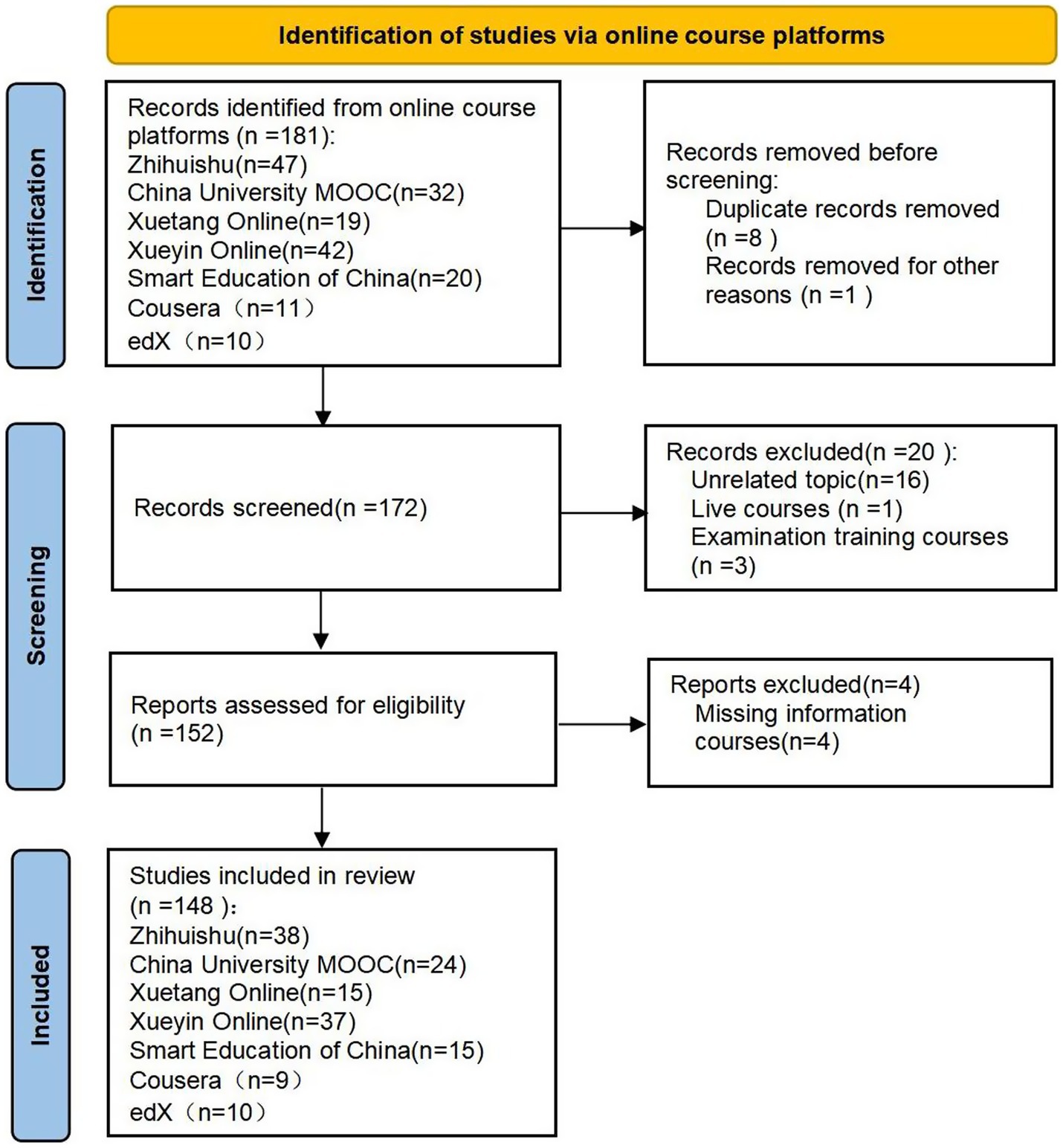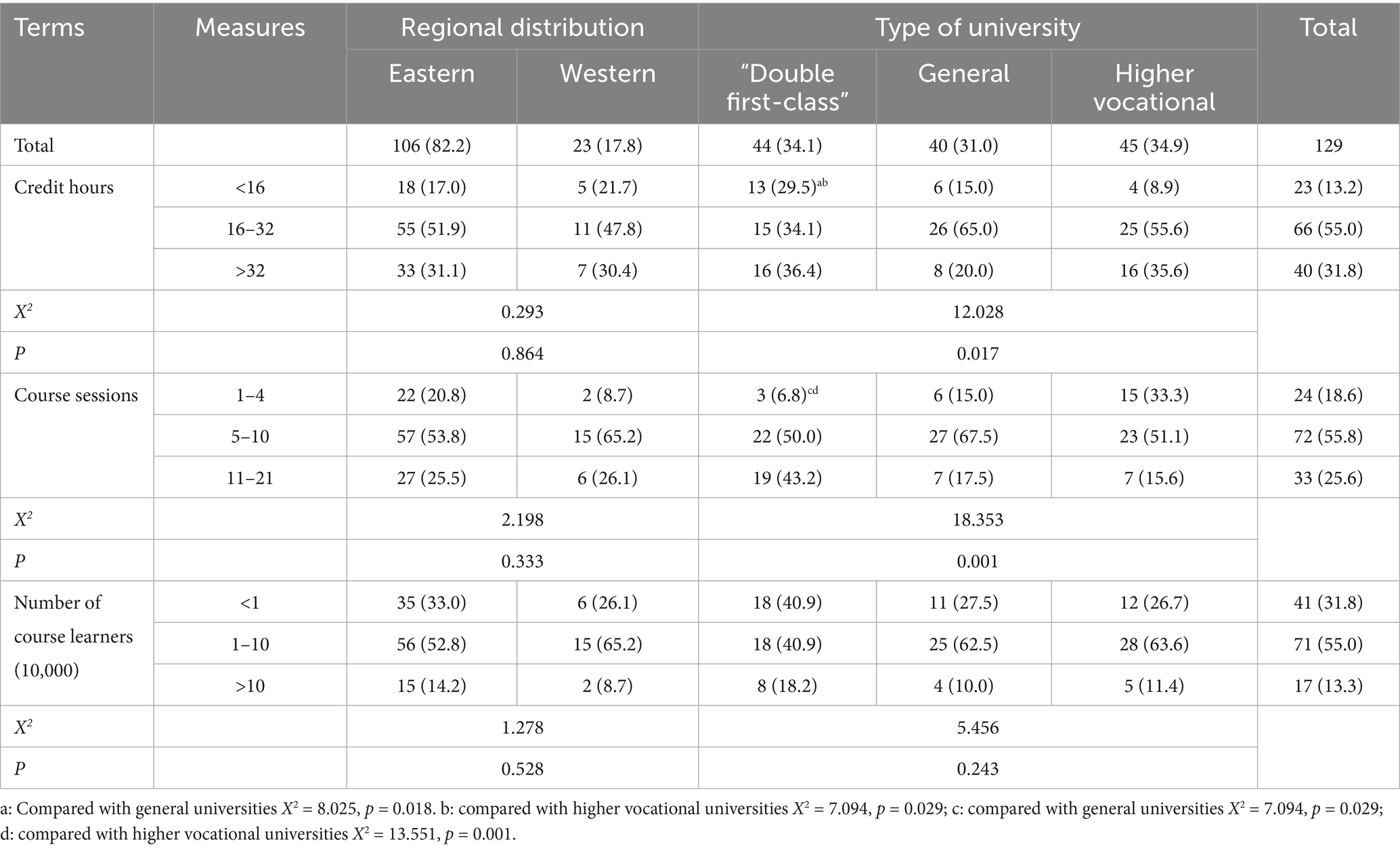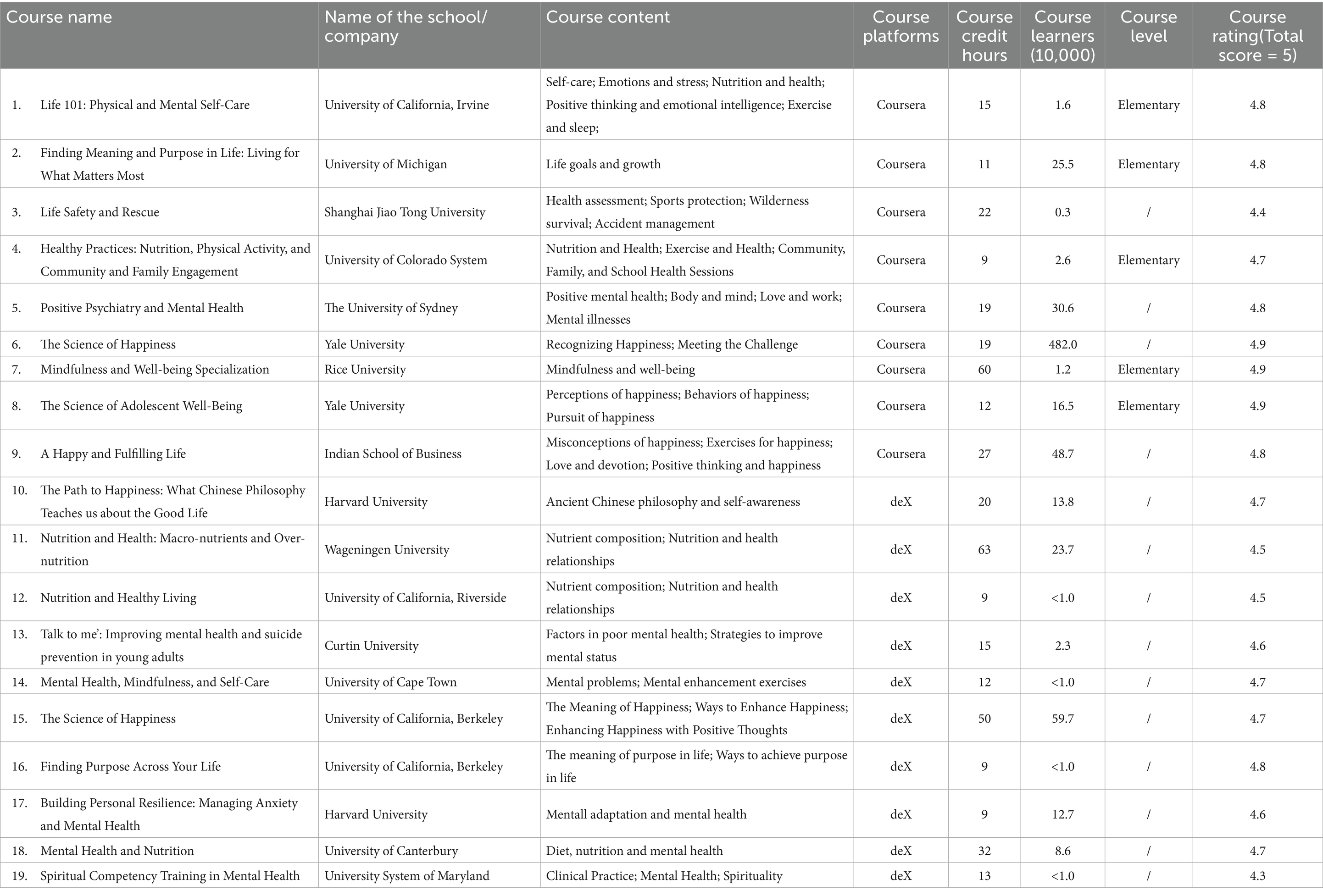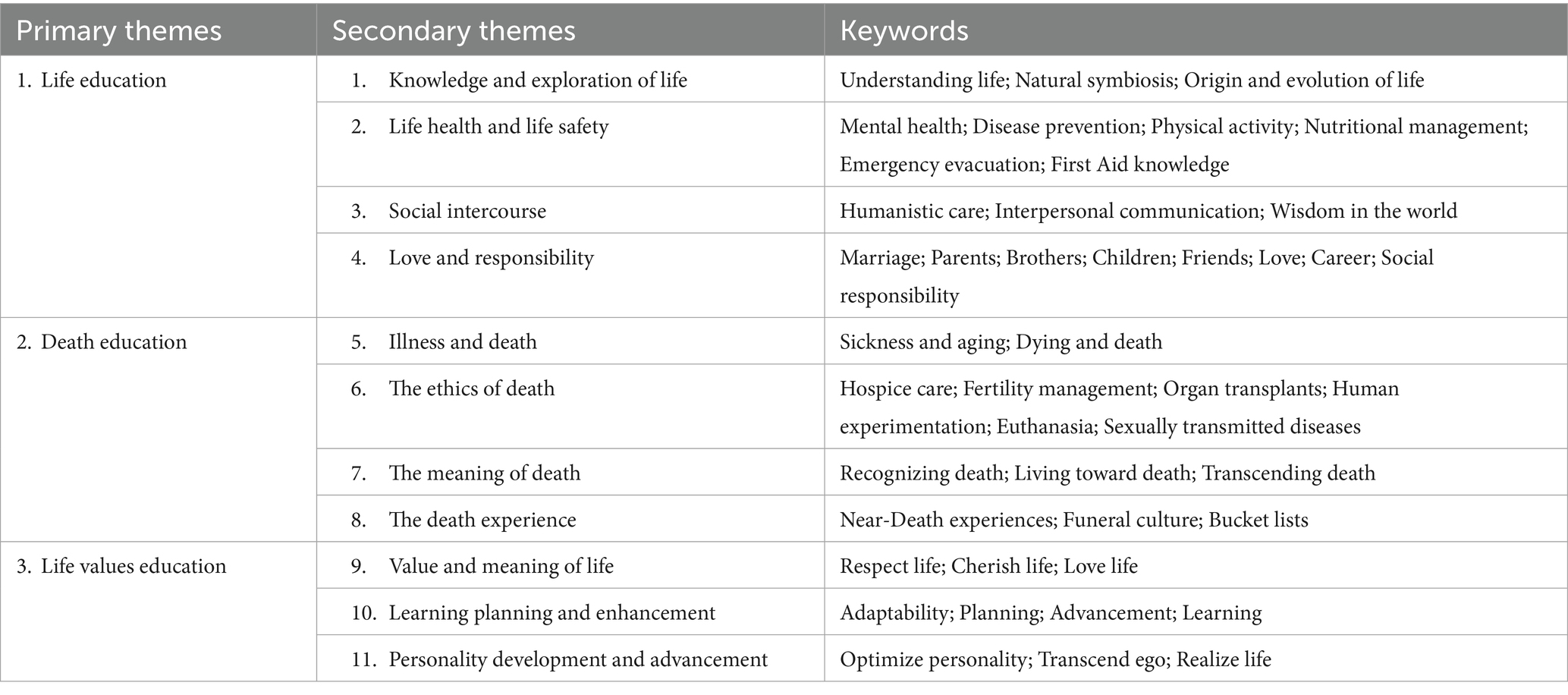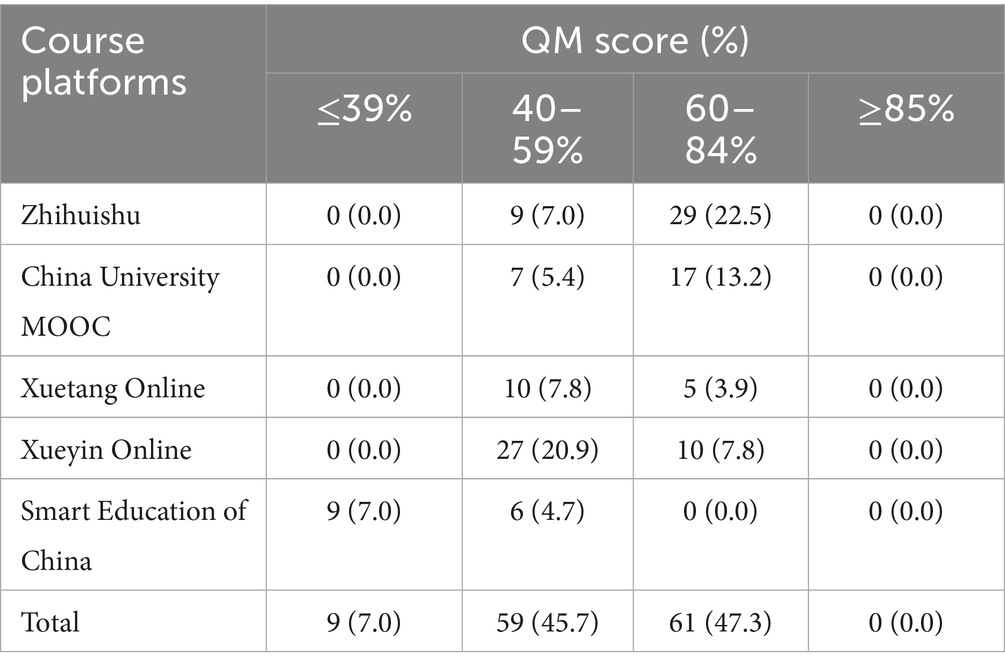- School of Nursing, Chongqing Medical University, Chongqing, China
Background: With the advancement of the Chinese “Internet Plus” paradigm, life education has expended through the implementation of Massive open online courses (MOOCs). However, limited research has focused on the present condition and attributes of the building of Chinese life education MOOCs.
Objectives: To systematically analyze the current status and attributes of life education MOOCs in China, assess the quality of the courses, and give a reference for the development of life education MOOCs in the country.
Methods: We select China’s online education platform and utilize the search terms “Health OR Life OR Death OR Psychology OR Nutrition OR Exercise OR Well-being OR Love OR Ethics” to identify MOOCs pertinent to life education. Analyze and summarize the courses about platforms, schools, regions, objectives, contents, assessments, credit hours, number of sessions and number of learners. The quality of the course was assessed utilizing Quality Matters (QM).
Results: In China, 129 life education MOOCs were provided in six online education platforms. The quantity of courses originating from “double first-class” universities, general universities and higher vocational universities was 44, 40, and 45, respectively. The quantity of courses from eastern regions was 106, while from western regions it was 23. The course contents covered three domains: life education, death education, and life value education. Credit hours, course sessions and the number of course learners exhibit statistically significant differences among regions and school types (p < 0.05). 47.3% of the QM scores were 60–84%, indicating subpar overall course quality. 19 life education MOOCs were provided in foreign platforms Coursera and edX, with 52.6% having course duration of less than 16 h and 47.4% catering to over 100,000 participants.
Conclusion: Chinese life education MOOC is resource-rich and has a substantial learner base. However, issues persist, including inconsistent course quality, limited personalization of course content, and significant disparities between eastern and western regions. In the future, Chinese life education MOOC should align with the development in Artificial Intelligence (AI) technology, address the disparities between Eastern and Western areas, and integrate with worldwide platforms.
1 Introduction
With the emergence of the “Internet Plus” model and the extensive utilization of contemporary information technology in China, medical online education has developed rapidly, resulting in the birth of many online educational practice modalities (1). In 2008, Dave Cormier initially introduced the notion of Massive Open Online Courses (MOOCs) (2). Wikipedia defines MOOC as “a type of course delivered online, open to an unlimited number of participants, allowing learners to access free courses and obtain corresponding certificates of completion (3).” MOOC consists of four fundamental components: (1) Massive: MOOC encompasses a substantial quantity of learners and educators, including all societal sectors with a desire for knowledge; (2) Open: MOOC education is characterized by its accessibility, allowing users to learn at any time and location, with courses offered at no cost; (3) Online: MOOC courses are delivered via the Internet to offer online resources; (4) Course: MOOC provides a comprehensive course framework, encompassing learning objectives, content, assessment, and certification as a foundation for course engagement (2).
Massive open online courses rely on the Internet online platforms to provide open and varied courses for learners globally (2). The advent of MOOCs has created a novel possibility for the advancement of medical education, transcending temporal and spatial constraints, and providing students with a plethora of systematic and professional materials to select from (4). Against the background of rapid economic and social development, constant changes in the natural environment, and intensifying social competitiveness, public health awareness is gradually increasing, prompting academics to focus increasingly on life education (5).
In the 1960s, in response to adolescents’ suicidal, self-injurious and other maladaptive behaviors, American researcher James Donald Walters pioneered the concept of life education and developed a corresponding school life education curriculum system (6). Since then, life education has progressively expanded worldwide. In recent years, college students have had considerable mental health issues, and they possess an ambiguous comprehension of their perspectives on life and death (7). Currently, life education in Chinese colleges and universities is inadequate, and the demand for life and death education among college students, particularly those in medical fields, is rising, necessitating an urgent enhancement of life education for these students (8). Consequently, various types of college life education have arisen as MOOCs, offering students an expanded array of learning opportunities. The development of life education programs in medical institutions has positively influenced medical students’ perspectives on life and death, fostering their comprehensive growth (8). At present, the majority of research on life education, both in China and internationally, consists of theoretical analyses and value reflections (9), with limited reports addressing the current state and characteristics of life education MOOC development. This study investigated the current status of life education MOOCs in universities to provide reference for enhancing the development of online life education courses and facilitating the dissemination of high-quality teaching resources.
2 Methods
2.1 Study design
This study gathers data from major online course platforms in China and internationally to compare and analyze the current status of life education MOOC development in China. The studies were approved by Ethics Committee of the Chongqing Medical University (2023070), on 3 September 2023. The studies were conducted in accordance with the local legislation and institutional requirements.
2.2 Participants
Based on the “China Digital Education Top 100 List in 2023”1 and the historical development of online education platforms in Chinese higher education (10), the major Chinese and international higher online education platforms were identified by evaluating platform registrations, subject categories, course offerings, and the representation of colleges and universities on these platforms. Five Chinese online education platforms, namely Zhihuishu2, Xueyin Online3, China University MOOC4, Smart Education of China5, and Xuetang Online6, were chosen, along with the international online education platforms Coursera7 and deX8 for course exploration. Inclusion criteria for online courses: (1) MOOC courses; (2) developed by higher education institutions; (3) freely accessible and open courses; (4) comprehensive course design. Exclusion criteria: (1) live courses; (2) examination training courses; (3) duplicate courses. The course screening flowchart is shown in Figure 1.
2.3 Methods
In contemporary society, life education for college students has emerged as a prominent and significant topic, encompassing a diverse array of educational content, including life awareness education, death education, and survival skills education (11). Therefore, we explored life education courses using the online education platform, employing the search terms “Health OR Life OR Death OR Psychology OR Nutrition OR Exercise OR Well-being OR Love OR Ethics” to identify relevant courses. The search deadline was April 5, 2024. To ensure the objectivity and accuracy of the data, one expert with a decade of higher education teaching experience, who has contributed to the development of online education, and two master’s degree students in the relevant field were engaged in data collection and evaluation.
2.4 Outcome indicators
Compilation of course details: Data on course platforms, course schools, course regions, course contents, course evaluations, course credit hours, number of course sessions and number of learners was collected through the online education platform system for generalization and analysis.
Criteria for Evaluating Course Quality: Quality Matters (QM)9 is one of the most popular and widely used curriculum quality assurance frameworks in the United States (12). It focuses on improving the quality of online courses at the K-12, higher education, and professional education sectors, comprising eight peer-reviewed criteria: (1) Course overview and introduction; (2) Learning objectives; (3) Assessment and measurement; (4) Instructional materials; (5) Learning activities and learner interaction; (6) Course technology; (7) Learner support; (8) Accessibility and usability. Each criterion encompasses more precise sub-criteria. QM scores range from 0 to 101, with each entry assigned a variable score of 1 to 3 points, awarded if the criterion is fulfilled and 0 if not. A total score of at least 85 is required to pass the review of a course.
2.5 Statistics
Statistical analyses were conducted with SPSS 26.0 software. Categorical variables were represented as frequencies and percentages. Comparisons of differences between the two cohorts were conducted using chi-squared tests, with P<0.05 as statistically significant.
3 Results
3.1 Origin and distribution of courses
In China, 129 life education MOOCs were available across five online education platforms, comprising 44 (34.1%) from “double first-class” universities, 40 (31.0%) from general universities, and 45 (34.9%) from higher vocational universities. The “Heihe-Tengchong line” divides China into eastern and western regions, with 106 courses (82.6%) were developed by universities in the eastern region, and 23 courses (17.8%) were developed by universities in the western region. The distribution of life education MOOCs is shown in Table 1.
The international platforms include Coursera and edX, with the 19 courses originating from prestigious institutions such as Yale University, Harvard University and Peking University, as shown in Table 2.
3.2 Course operation
The course operation contains three components: course credit hours, number of course sessions and number of course learners. In China, among the 129 life education MOOCs, course credit hours varied from 5–80 h, with 66 (55.0%) courses offering 16–32 h, the school type significantly influenced course (p < 0.05). Of the 129 life education MOOCs, 1–21 course sessions were offered, with 72 courses (55.8%) featuring a focus of 5–10 course sessions, equating to 2 periods every year, the school type significantly influenced course sessions(p < 0.05). Regarding the number of course learners, 71 courses (55.0%) had between 10,000 and 100,000 learners, while 17 courses (13.3%) exceeded 100,000 learners, as illustrated in Table 1.
Among the 19 life education MOOCs available on Coursera and edX, 10 courses (52.6%) offer fewer than 16 credit hours, 6 courses (31.6%) provide 16–32 credit hours, and 3 courses (15.8%) exceed 32 credit hours. Regarding course participants, there are 5 courses (26.3%) with fewer than 10,000 participants, 5 courses (26.3%) with 10,000 to 100,000 participants, and 9 courses (47.4%) with more than 100,000 participants, as shown in Table 2.
3.3 Assessment of fundamental components of courses
According to pedagogical theories, the fundamental components of the course encompass four aspects: objectives, contents, process, and evaluation (13). This research studies three areas of life education MOOC data in China and internationally: objectives, content, and assessment.
3.3.1 Objectives and contents of the course
Chinese life education MOOCs are structured on the central topic of “respecting and cherishing life” (14), encompassing 3 primary themes, 11 secondary themes and 453 keywords in this study. Each secondary theme encompasses various keywords, indicating that each course addresses an extensive array of content and subjects, as shown in Table 3. Of the primary themes, life education at 54.5%, life value education at 31.6%, and death education at 13.9%, as shown in Figure 2, with secondary themes exhibiting varying frequency distributions.
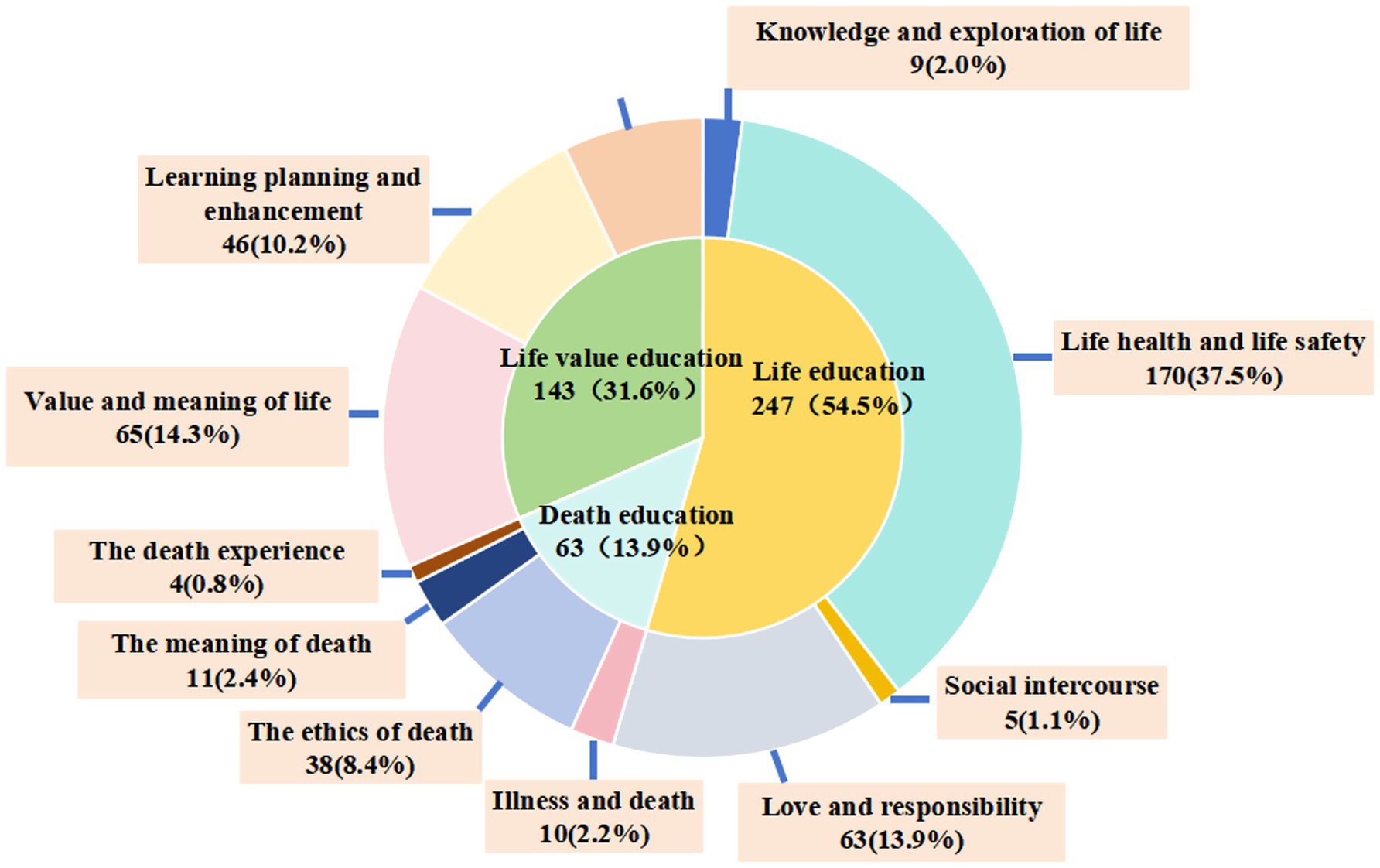
Figure 2. Pie chart of content distribution and frequency of themes in Chinese life education MOOCs [N = 453, times (%)].
The 19 courses offered by the Coursera and edX platforms, the topics are similar to those in China, with primary themes including “the meaning of life, life safety, physical and mental health, nutrition and health, and happy life.” However, the material covered in each course is very specialized, and numerous comprehensive and advanced courses have been developed, as shown in Table 2.
3.3.2 Course assessment
The Life education MOOC course is an online course, with assessment standard predominantly established by the platform. This includes the usual grades, chapter test scores, final examination results. Figure 3 illustrates the calculation formula of the Zhihuishu and China University MOOC platform, the percentage of grades of each platform is slightly different. Upon fulfilling the course requirements and assessment criteria, students may submit for certification, which will automatically produce the electronic form of the certificate.
3.4 Quality matters results
All 129 life education MOOCs in China received QM scores below 85, hence failing to satisfy the QM quality review passing standard. 61 courses (47.3%) received ratings ranging from 60 to 84, while the remainder scored below 60, as seen in Table 4. Regarding platform distribution, 29 courses (22.5%) on Zhihuishu and 17 courses (13.2%) on the China University MOOC platforms achieved scores between 60 and 84 points. Meanwhile, 15 courses (11.6%) on the Smart Education of China platform scored below 60 points, with 9 courses scoring below 40 points. Additionally, this platform was deficient in essential QM scoring components, including course introduction and course materials. Despite 27 courses in Xueyin Online receiving lower grades, the portal provides comprehensive course descriptions, objectives, and target audience criteria for each course.
The top five courses in China’s 129 life education MOOC rankings, according to QM rating, predominantly come from the Zhihuishu and China University MOOC platforms, primarily located in the eastern coastline region, with course levels mainly at the national and provincial tiers. The bottom 5 ranked courses mainly originated from higher vocational colleges and universities, and were mainly school-level courses, as shown in Table 5. The analysis of QM scores indicates that the top five courses fulfill the majority of the criteria, with the exception of “Dimension 7: Learner support,” “Dimension 1: Course overview and introduction” and “Dimension 2: Learning objectives.” Furthermore, the bottom 5 courses failed to enhance “Dimension 3: Assessment and measurement” and “Dimension 6: Course technology,” as shown in Table 6.
The QM compliance rate for 19 foreign courses is 80%. Most courses on the Coursera platform are categorized by learning levels, while the edX platform features participant ratings and evaluations, both of which adhere to QM scoring standards and offer guidance for learners in selecting the most appropriate courses.
4 Discussion
4.1 Life education MOOCs have achieved developments in China
In recent years, China attaches great importance to the development of the “Internet plus” model, with colleges and universities serving as the primary platforms for MOOC development, demonstrating greater efficacy in enhancing student learning compared to conventional teaching methods (15). This study shows the extensive availability of online course resources for life education in China, sourced from general colleges and universities and higher vocational colleges nationwide. Notably, platforms like Zhihuishu and China University MOOC aggregate resources from prestigious institutions, including Sichuan University and Shandong University, thereby offering high-quality educational materials for the advancement of life education in higher education institutions. The analysis found that the number of course learners surpassed 100,000, representing 13.3%, while the number of courses offered constituted 81.4% of the total, indicating that life education has become a significant component of China’s online education. This suggests that the MOOC model effectively addresses students’ learning requirements, and the platform’s infrastructure aligns with the technological and content needs of learners (16), consistent with China’s developmental trend to leverage the advantages of online education and enhance the accessibility of educational resources (17).
Nonetheless, disparities exist in the quantity of course sessions and the number of participants within the region housing 129 MOOC institutions, as well as in the type of institution (p < 0.05). The MOOC for life education in “double first-class” universities was established earlier, attracting a larger cohort of learners and achieving relatively high quality evaluation scores for QM courses. In contrast, higher vocational colleges and universities exhibit a deficiency in online course resources, with fewer courses, limited duration, and a smaller number of participants, indicating an imbalance in the distribution of MOOC resources for life education in China (18). This study reveals a significant disparity in the quality of resources and course utilization between eastern and western institutions, as well as between undergraduate and higher vocational institutions. This discrepancy hampers the effective utilization of MOOC resources in life education and impedes the widespread adoption of life education, reflecting the uneven distribution of health education resources across eastern and western China (19, 20). In the future, institutions in the East and West should adhere to the principle of “resource sharing and wisdom coexistence” to collaboratively develop standardized and exemplary online courses, thereby maximizing the dissemination and application of high-quality life education resources and ensuring equitable access to life education for all individuals.
4.2 Chinese life education MOOCs still need to learn from international platforms
The Coursera platform, established by Stanford University, was officially launched in 2012 to offer free online courses, followed by the edX platform, co-founded by Massachusetts Institute of Technology (MIT) and Harvard University in 2013 (21). The life education MOOCs in both platforms cover English and Chinese learning resources, and developed by globally renowned universities. The courses are exceptionally appealing and widely employed, drawing involvement from numerous learners and educational institutions. All life education MOOCs on Coursera have open student rating and commenting modules, which offer precise learning recommendations and a transparent evaluation method, hence facilitating effective learning and ongoing course enhancement for learners.
This study identified several deficiencies in Chinese life education MOOCs. The general quality of the course is substandard, with several courses deficient in fundamental components, including course descriptions, essential instructional resources, and economic and technical support. Secondly, the convergence of course content is evident, with the significant overlap among certain courses, which fails to meet the individualized learning requirements of diverse students. Third, the courses lack opportunities for student feedback regarding the learning experience and do not facilitate comment programs to address students’ particular requirements. Studies indicate that student evaluations might enhance course quality and hence elevate student satisfaction (22). However, most of the courses do not activate the student comment channel, disregarding the individualized requirements of students.
The Global MOOC and Online Education Conference, themed “Reconstruction of Future Higher Education in the Age of Intelligence” held in the UK in 2024. It proposes three initiatives aimed at establishing MOOC standardization and normative development, enhancing collaborative efforts, and fostering a global online education community (23, 24). Consequently, the development of life education MOOCs should prioritize interactive feedback among learners and between learners and course developers. The functionalities of student inquiries and learning forums in MOOCs facilitate the sharing of perspectives and experiences among learners, fostering the interplay and synthesis of ideas, as well as the exchange and exploration of knowledge. Concurrently, the analysis of student performance and interactions within these forums allows for precise assessment of learning outcomes, providing significant insights for educational practices (25). Chinese MOOC platforms ought to draw insights from international counterparts, bolster collaboration with higher education institutions, integrate MOOCs into the curriculum, develop credit and degree certification frameworks, and further refine the certification system for MOOC learning (26).
4.3 Creating a distinctive MOOC format for life education in the era of online learning
This study found that life education MOOCs effectively encompass the themes of life health, life awareness, life value and life pursuit, facilitating profound contemplation of life and death among college students. MOOCs are extensively utilized in higher education owing to their flexibility in time and location, their ability to transcend regional limitations, and their facilitation of resource sharing, and they are progressively included into lifelong education (27). At present, life education MOOCs on the same platform in China adhere to identical assessment standards as other MOOCs, ensuring the efficacy of online learning. Nonetheless, life education encompasses extensive information and varied formats, and the grading evaluation approach based on scores is not conducive to accurately assessing students’ learning outcomes. The 2024 World Conference on Digital Education in China, themed “Artificial Intelligence and Digital Ethics,” emphasized that digital education and artificial intelligence education represent the future trajectory of educational development (23, 24). In recent years, data mining of MOOCs has garnered scholarly interest, with numerous researchers examining forum data on MOOC platforms (25), which facilitates student interaction for learning course content, posing inquiries, discussing specific topics, and sharing opinions and experiences.
Therefore, life education MOOC should conform to the online education background, fully apply big data and cloud computing to accurately analyze individual learning needs (28). They should gather and evaluate students’ classroom behaviors, learning conditions, and needs in real time, promote timely submission of feedback and learning summaries by students, and establish a personalized and intelligent online course framework for life education, thereby fostering students’ motivation to persist in their learning endeavors (29). Furthermore, we can pursue the trend of Virtual Reality (VR) education (30) by developing a VR system that allows real-time experiences of significant life processes, such as ‘dying and death, ‘thereby providing students with immersive life education, enhancing the learning experience, and elevating the quality of life education MOOCs.
5 Strengths and limitations
The strength of this study is that it investigates the current status of 129 life education MOOCs in China, focusing on course source and distribution, operational aspects, fundamental course information, and quality assessment, while also comparing them with overseas platforms.
The limitation of this study is that it is a retrospective study and the five MOOC platforms selected represent only some of the courses and the selection of five MOOC sites, which may not encompass all high-quality MOOCs for life education. Moreover, the accessibility of data from online platforms precluded the evaluation of student feedback, interactions, and assignment completion; hence, future researchers should augment the sample size to get more comprehensive results.
6 Conclusion
Life education is one of the important component of collegiate education. This study provides a comprehensive analysis of the characteristics of MOOC development in life education inside Chinese higher education institutions. Chinese life MOOCs offer abundant course resources, extensive subject coverage, and emphasize ideological education and the promotion of humanistic values. However, there are still problems such as insufficient personalized design, ambiguous course evaluation system, significant disparities between the East and the West. In the future, we must adhere to the evolving trends of artificial intelligence and online education, consider the physical and mental developmental characteristics of modern university students, develop high-quality courses, bridge the divide between Eastern and Western regions, and engage with international platforms to disseminate scientific and superior life education MOOCs globally.
Data availability statement
The original contributions presented in the study are included in the article/supplementary material, further inquiries can be directed to the corresponding author.
Ethics statement
The studies involving humans were approved by Ethics Committee of the Chongqing Medical University. The studies In review were conducted in accordance with the local legislation and institutional requirements. The participants provided their written informed consent to participate in this study.
Author contributions
FX: Conceptualization, Data curation, Formal Analysis, Investigation, Methodology, Resources, Software, Writing – original draft. JZ: Data curation, Investigation, Methodology, Writing – original draft. QZ: Data curation, Formal Analysis, Methodology, Writing – original draft. SM: Funding acquisition, Methodology, Project administration, Supervision, Writing – review & editing.
Funding
The author(s) declare that financial support was received for the research and/or publication of this article. This work was supported by Chongqing Municipal Education Commission (YJG233056 and CYS23368).
Conflict of interest
The authors declare that the research was conducted in the absence of any commercial or financial relationships that could be construed as a potential conflict of interest.
Generative AI statement
The authors declare that no Gen AI was used in the creation of this manuscript.
Publisher’s note
All claims expressed in this article are solely those of the authors and do not necessarily represent those of their affiliated organizations, or those of the publisher, the editors and the reviewers. Any product that may be evaluated in this article, or claim that may be made by its manufacturer, is not guaranteed or endorsed by the publisher.
Footnotes
References
1. Shu, L, Longxiang, S, Ran, L, Ying, L, Hua, Z, and Li, J. Blended teaching mode based on small private online course and case-based learning in analgesia and sedation education in China: a comparison with an offline mode. BMC Med Educ. (2024) 24:28. doi: 10.1186/s12909-023-04839-4
2. Mahajan, R, Gupta, P, and Singh, T. Massive open online courses: concept and implications. Indian Pediatr. (2019) 56:489–95. doi: 10.1007/s13312-019-1575-6
3. Wikipedia (2014) Massive Open Online Course. Available at: http://en.wikipedia.org/wiki/Massive_open_online_course (Accessed 13 February 2025).
4. Longhini, J, De Colle, B, Rossettini, G, and Palese, A. What knowledge is available on massive open online courses in nursing and academic healthcare sciences education? A rapid review. Nurse Education Today. (2021) 99:104812. doi: 10.1016/j.nedt.2021.104812
5. Olsen, JA, Chen, G, and Lamu, AN. The relative importance of education and health behaviour for health and wellbeing. BMC Public Health. (2023) 23:1981. doi: 10.1186/s12889-023-16943-7
6. Donald, Walters James, and Yin,. (2006) Education for life: preparing children to meet the challenges. revised edition. Chengdu: Sichuan University Press
7. Meng, L, Yi, L, and Li, T. The collision between the classroom voice(s) and the voice of the mainstream culture on end-of-life to cultivate students’ attitudes toward death in China. Front Psychol. (2022) 13:879787. doi: 10.3389/fpsyg.2022.879787
8. Su, F-J, Zhao, H-Y, Wang, T-L, Zhang, LJ, Shi, GF, and Li, Y. Death education for undergraduate nursing students in the China Midwest region: an exploratory analysis. Nurs Open. (2023) 10:7780–7. doi: 10.1002/nop2.2025
9. Gao, Y, Yu, C, and Wang, H. Survey on the current situation of teacher students’ view of life and life education and suggestions for improvement. J Teach Educ. (2023) 10:78–88. doi: 10.13718/j.cnki.jsjy.2023.02.009
10. Li, F. Historical overview of the development of online courses in higher education. J High Educ. (2022) 8:96–9. doi: 10.19980/j.CN23-1593/G4.2022.36.024
11. Phan, HP, Ngu, BH, Hsu, C-S, and Chen, SC. Advancement of life and death education research: recommending implementation of the life + death education framework for teaching and research purposes. Front Public Health. (2024) 12:1440750. doi: 10.3389/fpubh.2024.1440750
12. Lowenthal, P, and Hodges, C. In search of quality: using quality matters to analyze the quality of massive, open, online courses (MOOCs). Int Rev Res Open Distrib Learn. (2015) 16:83–101. doi: 10.19173/irrodl.v16i5.2348
13. Hunkins, F P, and Ornstein, A C (2016) Curriculum: foundations, principles, and issues, global edition. global edition. Available at: https://xueshu.baidu.com/usercenter/paper/show?paperid=21bd125ea6460a83b9a064533331e2ae&site=xueshu_se (Accessed 26 May, 2025)
14. Liu, J, and Ma, M. Research on life education based on individual life characteristics, vol. 253. Beijing: China Social Sciences Press (2021).
15. Gao, J, Yang, L, Zou, J, and Fan, X. Comparison of the influence of massive open online courses and traditional teaching methods in medical education in China: a meta-analysis. Biochem Mol Biol Educ. (2021) 49:639–51. doi: 10.1002/bmb.21523
16. Huang, F, and Yang, B. Reflections on the status quo, dilemmas and path construction of online education in colleges and universities under the perspective of new media. Chuanbo Yu Banquan. (2023):112–4. doi: 10.16852/j.cnki.45-1390/g2.2023.11.006
17. Zhan, Z, Su, Z-W, and Chang, H-L. Education and quality of life: does the internet matter in China? Front Public Health. (2022) 10:860297. doi: 10.3389/fpubh.2022.860297
18. Guo, Y, Li, G, and Chen, W. Regional differences of mass online teaching among China’s colleges and universities: an empirical study based on a survey of instructors and students during Covid-19 outbreak. Res Educ Develop. (2020) 40:37–48. doi: 10.14121/j.cnki.1008-3855.2020.11.007
19. Liu, Q, and Guo, Y. Regional differences of individual and allocation efficiencies of health resources in China. Front Public Health. (2023) 11:1306148. doi: 10.3389/fpubh.2023.1306148
20. Tang, MM, Zeng, Z, and Lan, Q. How to evaluate the efficiency of rural preschool education resources and its regional differences in China. Sci Rep. (2024) 14:22705. doi: 10.1038/s41598-024-72892-0
21. Liyanagunawardena, TR, Adams, AA, and Williams, SA. MOOCs: a systematic study of the published literature 2008-2012. Int Rev Res Open Distrib Learn. (2013) 14:202. doi: 10.19173/irrodl.v14i3.1455
22. Albelbisi, NA, Al-Adwan, AS, and Habibi, A. Self-regulated learning and satisfaction: a key determinants of MOOC success. Educ Inf Technol. (2021) 26:3459–81. doi: 10.1007/s10639-020-10404-z
23. Ministry of Education of the People’s Republic of China (2024) Global MOOC and Online Education Conference. Available online at: http://www.moe.gov.cn/jyb_xwfb/gzdt_gzdt/moe_1485/202412/t20241213_1166952.html (Accessed January 24, 2025).
24. Ministry of Education of the People’s Republic of China (2024) Parallel session on ‘Artificial Intelligence and Digital Ethics’ at the World Conference on Digital Education 2024. Available online at: http://www.moe.gov.cn/jyb_xwfb/xw_zt/moe_357/2024/2024_zt02/pxhy/pxhy_znll/pxhy_znll_mtbd/202402/t20240201_1113906.html (Accessed March 10, 2024).
25. Fu, S, Zhao, J, Cui, W, and Qu, H. Visual analysis of MOOC forums with iForum. IEEE Trans Vis Comput Graph. (2017) 23:201–10. doi: 10.1109/TVCG.2016.2598444
26. Li, H, Gu, H, Hao, X, Yan, X, and Zhu, Q. Data-driven analytics for student reviews in China’s higher vocational education MOOCs: a quality improvement perspective. PLoS One. (2024) 19:e0298675. doi: 10.1371/journal.pone.0298675
27. Alhazzani, N. MOOC’s impact on higher education. Soc. Sci. Humanit. Open. (2020) 2:100030. doi: 10.1016/j.ssaho.2020.100030
28. Goldberg, LR, and Crocombe, LA. Advances in medical education and practice: role of massive open online courses. Adv Med Educ Pract. (2017) 8:603–9. doi: 10.2147/AMEP.S115321
29. Rhim, HC, and Han, H. Teaching online: foundational concepts of online learning and practical guidelines. Korean J Med Educ. (2020) 32:175–83. doi: 10.3946/kjme.2020.171
Keywords: life education, MOOC, online courses, curriculum development, quality assessment
Citation: Xu F, Zhang J, Zhou Q and Mou S (2025) MOOC construction for life education in Chinese universities: an analytical study. Front. Public Health. 13:1569881. doi: 10.3389/fpubh.2025.1569881
Edited by:
María Dolores Ruiz Fernández, University of Almeria, SpainReviewed by:
Desak Gede B. K., University of Indonesia, IndonesiaAli Mansoor Al-Ameri, University of Karbala, Iraq
Copyright © 2025 Xu, Zhang, Zhou and Mou. This is an open-access article distributed under the terms of the Creative Commons Attribution License (CC BY). The use, distribution or reproduction in other forums is permitted, provided the original author(s) and the copyright owner(s) are credited and that the original publication in this journal is cited, in accordance with accepted academic practice. No use, distribution or reproduction is permitted which does not comply with these terms.
*Correspondence: Shaoyu Mou, NjQzMTYzODc3QHFxLmNvbQ==
†These authors share first authorship
 Fengling Xu
Fengling Xu Junqing Zhang
Junqing Zhang Qiqi Zhou
Qiqi Zhou Shaoyu Mou
Shaoyu Mou